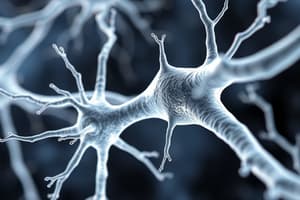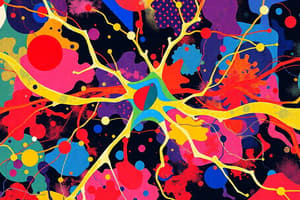Podcast
Questions and Answers
What is a neuron responsible for?
What is a neuron responsible for?
Sending and receiving messages in the body.
Which ions are primarily found in the intracellular fluid (ICF)?
Which ions are primarily found in the intracellular fluid (ICF)?
- Sodium (Na+)
- Chloride (Cl-)
- Potassium (K+) (correct)
- Calcium (Ca2+)
Which ions are primarily found in the extracellular fluid (ECF)?
Which ions are primarily found in the extracellular fluid (ECF)?
- Phosphate (HPO4^2-)
- Proteins
- Potassium (K+) (correct)
- Sodium (Na+) (correct)
What is the function of the cell body in a neuron?
What is the function of the cell body in a neuron?
What initiates an action potential in a neuron?
What initiates an action potential in a neuron?
What is the typical value of resting potential in a neuron?
What is the typical value of resting potential in a neuron?
The all-or-nothing principle states that an action potential can occur partially.
The all-or-nothing principle states that an action potential can occur partially.
What is the primary excitatory neurotransmitter in the central nervous system?
What is the primary excitatory neurotransmitter in the central nervous system?
What is the role of inhibitory neurons?
What is the role of inhibitory neurons?
Study Notes
Generating Action Potentials
-
Intracellular Fluid (ICF): Dominated by Potassium ions (K+), Phosphate ions (HPO4^2-), Proteins, and Sodium ions (Na+).
-
Extracellular Fluid (ECF): Composed mainly of Sodium ions (Na+), Chloride ions (Cl-), Calcium ions (Ca2+), and Potassium ions (K+).
-
Electrochemical Gradient: Combines chemical and electrical gradients influencing ion movement across membranes.
-
Chemical Gradient: Formed by differences in ion concentration, driving ions from high to low concentration areas.
-
Electrical Gradient: Created by differences in charge across membranes, attracting ions to areas with opposite charges.
Structure of Neurons
-
Neuron Function: Special cell type transmitting and receiving signals for body communication.
-
Cell Body: Control center, processes incoming signals, and supports neuron health.
-
Components of the Cell Body:
- Nucleus: Contains DNA.
- Cytoplasm: Houses organelles like mitochondria (energy) and ribosomes (protein synthesis).
-
Dendrites: Receive signals from other neurons, conduct messages to the cell body.
-
Axon: Transmits electrical impulses away from the cell body.
Components of Axon
-
Axon Hillock: Cone-shaped region for action potential initiation.
-
Myelin Sheath: Insulates axon, enhancing signal transmission speed.
-
Nodes of Ranvier: Gaps in myelin where ion channels are concentrated, facilitating action potential jumping.
-
Axon Terminals: Endpoints where neurotransmitters are released into the synapse.
Ion Movement and Diffusion
-
Diffusion: Movement of particles from higher to lower concentration, critical for ion movement across membranes.
-
Ion Channels: Proteins allowing specific ions to pass through cell membranes.
-
Ion Pumps: Active transport mechanisms using ATP to move ions against concentration gradients.
-
Sodium-Potassium Pump (Na+/K+ ATPase): Moves 3 Na+ ions out and 2 K+ ions into the cell, maintaining ion concentration gradients.
The Resting Potential
-
Resting Potential: Electrical potential difference of approximately -70 mV when the neuron is inactive, inside being negatively charged relative to outside.
-
Permeability: Refers to the membrane's ability to allow certain substances to pass while blocking others.
The Action Potential
-
Action Potential: Rapid change in membrane potential traveling along the axon.
-
Depolarization: Occurs when Na+ ions flow into the neuron, making the membrane potential less negative.
-
Threshold: Action potential initiated when membrane potential reaches approximately -55 mV.
-
All-or-Nothing Principle: Action potential either occurs fully or not at all once the threshold is hit.
-
Refractory Period: Time following an action potential where another cannot be initiated.
Excitatory and Inhibitory Neurons
-
Excitatory Neurons: Encourage firing of action potentials in receiving neurons.
- Example: Glutamate is the primary excitatory neurotransmitter in the central nervous system.
-
Inhibitory Neurons: Reduce the likelihood of action potential firing in postsynaptic neurons.
Studying That Suits You
Use AI to generate personalized quizzes and flashcards to suit your learning preferences.
Related Documents
Description
This quiz explores the structure of neurons and their role in generating action potentials, focusing on the intracellular fluid (ICF) and the major ions present. Test your understanding of the intricate processes that enable neuronal communication and function.



